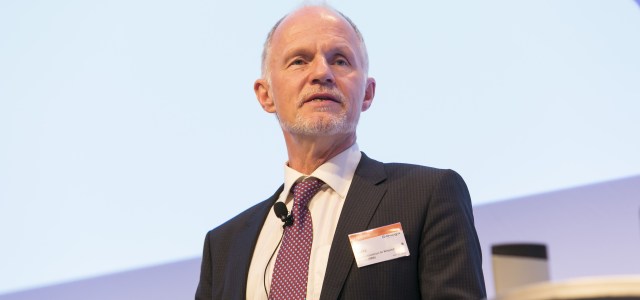In mid-January, German State Secretary in the Ministry for Economic Affairs and Energy Rainer Baake spoke at a Handelsblatt conference about the future power market design. We need to get used to a few new terms, Craig Morris explains why.

Baake giving some insight in the government’s ideas for the future power market design. (Photo by EUROFORUM/Dietmar Gust)
If you speak German, the video is available here. Below, I sum up the findings.
First, the moderator says there is agreement that there is “surplus capacity” on the market, and Baake himself speaks of surplus capacity in Europe, not just Germany. This statement is important in light of the simultaneous concerns about a possible shortfall in generation capacity during the nuclear phaseout. It seems there is a middle ground that needs to be found – some capacity needs to be taken down, but there is a risk of too much disappearing in the process.
 Otherwise, the discussion focused on capacity markets, which both Industry Minister Sigmar Gabriel and Chancellor Angela Merkel publicly opposed last month. As I recently explained, the rollout of a capacity market may have been simply postponed, not canceled, and Baake’s comments go along the same lines. He says he has not made up his mind on whether capacity markets are needed or whether peak price signals will do the job. The question is whether shortfalls in power supply will trigger prices high enough for plants that rarely cut on to remain in operation over the year. If too many of these plants rarely used are shut down, there may eventually be a blackout. Taken together, the comments made by Gabriel, Merkel, and Baake seem to suggest that the current overcapacity gives us a couple of years to test the waters and see whether peak price signals will work.
Otherwise, the discussion focused on capacity markets, which both Industry Minister Sigmar Gabriel and Chancellor Angela Merkel publicly opposed last month. As I recently explained, the rollout of a capacity market may have been simply postponed, not canceled, and Baake’s comments go along the same lines. He says he has not made up his mind on whether capacity markets are needed or whether peak price signals will do the job. The question is whether shortfalls in power supply will trigger prices high enough for plants that rarely cut on to remain in operation over the year. If too many of these plants rarely used are shut down, there may eventually be a blackout. Taken together, the comments made by Gabriel, Merkel, and Baake seem to suggest that the current overcapacity gives us a couple of years to test the waters and see whether peak price signals will work.
But even in the future, the German government wants to keep a lid on any capacity payments made. In his presentation, Baake reiterated Gabriel’s position that the focus should be on ensuring dispatchable capacity, not saving existing plants that simply may not be needed.
In my previous post on the matter, I suggested that the new capacity market might just be an expansion of the strategic reserve. Baake is clear that, in one crucial respect, this is not true. As it currently exists, the strategic reserve kicks in when the price on the exchange reaches a certain level. As German economics research institute DIW explains (PDF in German), the power plants in the strategic reserve receive a flat rate for the year to cover their operating expenses and then a high rate for each kilowatt-hour generated. In return, these plants cannot sell any electricity on the wholesale market.
The capacity reserve being discussed is different. Baake opposes the idea of a price signal for these plants. If the price is, say, 10 cents per kilowatt-hour for the reserve to be activated, “why would anyone offer more?” he wonders. Once that price level is reached, Baake believes the market would expect the strategic reserve to kick in. Essentially, any price the policy sets would constitute the government deciding what a maximum price should be, and the German government believes that decision should be left up to the market.
In other words, the capacity reserve should be based on a different signal – not price, but an actual need for additional electricity to stabilize the grid. In comparing the capacity reserve and the strategic reserve, Baake says it is like “wearing a belt along with suspenders.”
Finally, I have been collecting evidence indicating that the application of the renewable energy surcharge to power consumed on-site is partly intended to prevent people from leaving the grid. In his speech, Baake states the following:
“The shift towards on-site consumption means that fewer entities will be covering the cost of the grid, the renewable energy surcharge, etc. That is not sustainable. All existing systems were exempted from the surcharge, but the European Commission then told us we are not treating everyone equally.”
This statement came as a response to a question from the audience about the imposition of the renewable energy surcharge on cogeneration units run by industry. Baake clearly includes “the cost of the grid” as one reason for the imposition of the surcharge. I do not believe we have had such a clear admission up to now.
Craig Morris (@PPchef) is the lead author of German Energy Transition. He directs Petite Planète and writes every workday for Renewables International.
If you want to cover fixed fees break out some portion of T&D charges. Increasing the use of electricity by electrifying heating should also help counter the trend toward self consumption.
It will be very interesting to see how the new off-shore wind capacity performs between now & 2022. I mention this because capacity factors tend to be asymmetric and you could expect a high capacity factor in the winter (perhaps 60 – 65%). This starts to look dispatchable.